
MRI as Good as Cardiac Catheterization for Diagnosing Coronary Heart Disease

When it comes to deciding which treatment is best for patients with chest pain and coronary heart disease (CHD), doctors will typically base the decision on how constricted the arteries serving the heart are. Doctors usually asses this by performing cardiac catheterization, which is an invasive procedure. The results of a new study show that a non-invasive procedure, known as magnetic resonance imaging (MRI), can provide as much information as cardiac catheterization.
Also known as coronary artery disease, CHD is the most common type of heart disease, according to the U.S. National Library of Medicine. CHD is also the leading cause of death in men and women in the nation. It occurs when cholesterol and other materials, known collectively as plaque, build up on the inside of the coronary arteries that supply blood to the heart. The accumulation of plaque hardens and narrows the coronary arteries, which prevents the heart from getting the oxygen-rich blood it needs to function. CHD can lead to chest pain and, over time, weaken the heart muscles and contribute to irregular heartbeat and heart failure.
About Cardiac Catheterization
Cardiac catheterization is a procedure that involves inspection of the coronary artery with the help of a long, thin tube, known as a catheter. To perform cardiac catheterization, a heart surgeon inserts a catheter into an artery or vein in the patient’s going, neck or arm and threads the catheter through to the patient’s heart. Cardiac catheterization provides information about the location of narrowing or blockages in the coronary artery. Sometimes the surgeon will measure blood pressure in different areas of the heart as part of the cardiac catheterization procedure. Doctors use the information they learn gather to develop a suggested course of treatment for CHD.
Heart surgeons also perform cardiac catheterization as a treatment to open up a blocked blood vessel or valve, dilate arteries in the heart, and even repair holes in the heart.
Cardiac catheterization is an invasive procedure that requires anesthesia. Following the procedure, patients spend a couple of hours in the recovery room, recovering from anesthesia.
Surgeons perform more than a million cardiac catheterizations each year. While the risks of major complications during diagnostic cardiac catheterization are less than 1 percent, any invasive cardiac procedure presents a risk. Cardiac catheterization risks include allergic reaction to anesthesia or other medications used in the procedure, blood clots that can trigger a heart attack or stroke, bleeding or infection at the catheter insertion site, damage to the artery, irregular heartbeat, low blood pressure and even torn heart tissue.
While the risk of one of these adverse events is low, eliminating the risk altogether with an alternate test is best, especially if the alternate test provides the same quality results as cardiac catheterization.
The results of the new research suggest that cardiac MRI may be on par with cardiac catheterization. Cardiac MRI is a non-invasive imaging test that can be performed in about 40 minutes. The test also provides direct measurements of blood flow to the heart. Cardiac MRI uses radio waves, a powerful magnet, and a computer to create images of the heart.
Using MRI instead of Cardiac Catheterization to Guide CHD Treatment Decision-Making
Researchers from Goethe University in Frankfort, Germany, were able to demonstrate that the measurements obtained by cardiac MRI are as safe as cardiac catheterization for guiding the decision-making process.
Using information from the international MR-INFORM study, the research team examined 918 patients whose signs and symptoms of CHD indicated cardiac catheterization to see if using an MRI scan led to the same decision-making results.
The researchers assigned the participants to one of two groups. Participants in one group underwent standard diagnostic care with cardiac catheterization. Those in the other group had the 40-minute MRI scan of the heart; the results of the test would guide the decision whether the patient should undergo cardiac catheterization as a treatment.
The scientists followed the participants for a year, documenting how many died, suffered a heart attack, or required another heart test. The researchers also documented whether the heart symptoms continued.
They found that fewer than half of those who underwent MRI subsequently needed cardiac catheterization or further heart testing. This means that using the fast and non-invasive MRI scans as the first test can reduce cardiac catheterization as both a diagnostic test and as a CHD treatment.
The researchers also found that there was no difference between the two groups when it came to continuing symptoms, the development of new symptoms, complications, or deaths.
In other words, the results of cardiac MRI are just as good as the result of cardiac catheterization. MRI is also non-invasive, fast and convenient, and it has a much lower risk of complications.




